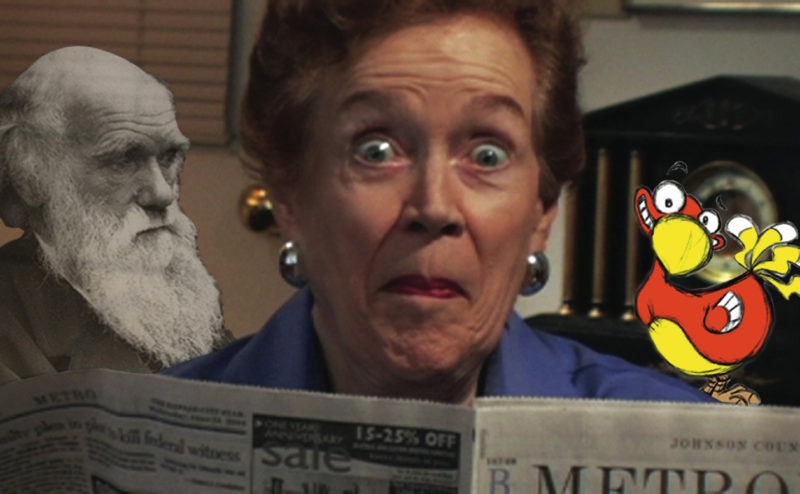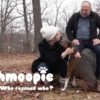
Dodos, Design and DNA
Written by Nancy L. Babine | Posted by: Anonymous
Flock of Dodos: The Evolution-Intelligent Design Circus, evolutionary biologist Randy Olson’s documentary film, is aptly titled. In an exploration of the sometimes acrimonious, sometimes absurd debate between proponents of evolution and intelligent design, Olson traveled from Kansas to Massachusetts, speaking with experts on both sides of the issue. The result is a lighthearted and humorous examination of the two camps, achieved with the help of dancing dodos, a poker game and a feisty octogenarian named Muffy Moose, who just happens to be Olson’s mom.
That a scientist would leave the world of research and academia to become a filmmaker was less an aberration, according to Olson, than it was a natural progression. Olson has always been a storyteller. “What I enjoyed most about marine biology and going to far-flung places for research was coming back and giving slide shows about my adventures. Story-telling has been a unifying factor between both careers.”
The son of a career military man Olson’s fascination with the ocean began in early childhood when his father was stationed in Hawaii and continued throughout his school years. He developed a keen interest in scuba diving and hoped to become a diver, exploring underwater shipwrecks. With no intentions of pursuing a degree in the field of science, he began his college career majoring in economics. Ultimately, his childhood curiosity about ocean life burgeoned into his pursuit of a PhD in evolutionary biology, which he was awarded from Harvard University in 1984.
With the support of post doctoral fellowships, Olson spent his first few years out of Harvard conducting extensive research on coral reefs and other marine organisms before accepting a teaching position at the University of New Hampshire (UNH), where he taught marine biology.
In 1989 while at UNH, Olson was invited to serve in the role of marine expert on a Scandinavian cruise. Using a microscope hooked into TV sets in the ship’s lounge, he regaled passengers with images of the ship’s plankton. He was struck by the powerful effect the moving images had on his enraptured audience. Back at UNH, Olson pursued his interest, producing short films on the subject of marine life, including Barnacles Tell No Lies, Lobstahs, and Salt of the Earth, which was broadcast on local PBS.
As Olson became more captivated by filmmaking he grew dissatisfied with the lack of creativity and innovation in documentary films covering scientific material. Convinced that even complex scientific information could and should be accessible to the general population and that film was the most obvious means to that end, Olson left his teaching post at UNH and at the age of 38 enrolled in film school at the University of Southern California.
Olson’s attention was drawn to the evolution-intelligent design debate in 2005 when his mother, Muffy Moose, who lives in Kansas, began sending newspaper articles about a bitter argument taking place in the Kansas School Board. The school board, an elected body, was split over the issue of teaching intelligent design alongside evolution in science classes in Kansas public schools. Not an unusual occurrence for Olson’s mom to provide him with hometown news (Olson’s family moved to Kansas after his father’s retirement from the army) he gave the articles only a cursory glance and set them aside. Some time later when the Kansas controversy garnered national press Olson read a story about the debate in New Yorker magazine. He remembered the articles and that attorney and geologist John Calvert, a key figure in the intelligent design movement, was his mother’s neighbor. All at once he knew this was the film he would make. “In an instant it came together,” he said. “It was a convergence of everything: my background as a biologist, my filmmaking experience, my Kansas upbringing.”
A strong believer in the value of spontaneity, he wasted no time. Rather than spend months researching and seeking funding sources Olson and two friends almost immediately began filming in Kansas, where the issue of science curriculum was being hotly argued. He interviewed several principal players in the fracas: Calvert, school board members, educators, scientists, and none other than his mom, Muffy Moose.
Initially, Olson’s plan was that Muffy’s contribution would be limited to one on-camera shot. He directed her to do nothing more than stand on her front porch and point in the direction of Calvert’s house. When animation artist Tom Sito saw the footage, in which Muffy added her own interpretation of the role and performed a little dance, he persuaded Olson to have her speak. The addition of Muffy’s voice only created a desire for more. “She’s the best thing you’ve got!” Sito told Olson. Olson followed his advice, giving Muffy several screen appearances, enhancing the folksy quality of the film.
Olson spent a week in Kansas, approaching the filming with a spirit of investigation. He relied only minimally on notes for his interviews, preferring to allow a flow of friendly conversation. Much of what he did in Kansas was without any sort of plan for how it would fit into the film. “I had no idea how it would work,” Olson said, “but I intuitively knew somehow it would.”
More travel followed, heading east for additional filming: interviews with a Lehigh University professor, a leading scientist in the intelligent design camp and with school board members in Dover, Pennsylvania who were involved in their own school board division, a visit to the Yale University dodo exhibit and finally on to Harvard University, where he met with seven colleagues, scientists with PhDs in evolution.
Olson was determined to avoid the “talking heads” component of so many films of a scientific nature. Rather than conduct seven separate one-on-one interviews he arranged a poker game and filmed the unscripted conversation. The audience is simultaneously informed and entertained as bombastic personalities vie for the floor. Droll humor reinforces Olson’s point that scientists need to come down from ivory towers and speak in terminology understandable to the layperson. Each time a 50-cent polysyllabic word is used, action stops abruptly and a black screen displays the word and its definition. One has the sense Olson enjoys good-naturedly poking fun at his own.
Olson uses other clever devices to infuse humor and lightheartedness. Animated dodos intermittently frolic across the screen to underscore his criticism of the scientific community’s resistance to adapt its style of communication to the current mass media culture. Dodos, an extinct species, are believed to have disappeared from the earth because they didn’t adapt to their changing environment. A pie chart is an actual pie, apple, with a lattice crust. A lively pace is established by frequent intercutting, including clips from old black and white newsreels. The film accomplishes that which Olson challenges the scientific community to do: effectively communicate complex scientific data by employing contemporary media techniques. In fact, he clearly has so much fun doing it he makes the task look easy.
While Olson has enjoyed much cooperation from museums and academia both in making the film and in the marketing phase, there continues to be a lack of support from the scientific community. He hopes the film will not only pave the way for improved dialogue between the proponents of evolution and intelligent design, but that the scientific community will be challenged to examine prevailing ineffective methods of communication.
Flock of Dodos has been widely screened at festivals, museums and college campuses throughout the country. It has received critical praise and enthusiastic response from audiences. Multiple screenings will take place in February to tie in with Charles Darwin’s birthday. Flock of Dodos will air on Showtime in May. The home video release date is set for July.
True to his belief in the value of spontaneity, Olson hasn’t made plans for his next project. For now he’s enjoying screening the movie all over the country and speaking with audiences during the Q&A sessions that follow. As for the late-blooming film star, Muffy Moose, she’s having the time of her life!
Flock of Dodos: The Evolution-Intelligent Design Circus will screen at the Museum of Fine Arts, Boston, on Saturday, February 17th. Olson and his mother, Muffy Moose, will be on hand for a Q&A session to follow the screening. More information about the film can be found at www.flockofdodos.com.










